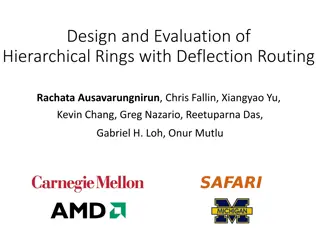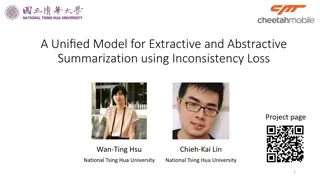Data Summarization with Hierarchical Taxonomy: Motivations and Examples
The research discusses the use of Hierarchical DAGs in summarizing data with a focus on disease ontology and animal diseases. It explores how general concepts can summarize specific items and their relationships. The study also presents motivated examples of popular papers summarization in SIGMOD, showcasing paper download trends.
Download Presentation

Please find below an Image/Link to download the presentation.
The content on the website is provided AS IS for your information and personal use only. It may not be sold, licensed, or shared on other websites without obtaining consent from the author.If you encounter any issues during the download, it is possible that the publisher has removed the file from their server.
You are allowed to download the files provided on this website for personal or commercial use, subject to the condition that they are used lawfully. All files are the property of their respective owners.
The content on the website is provided AS IS for your information and personal use only. It may not be sold, licensed, or shared on other websites without obtaining consent from the author.
E N D
Presentation Transcript
Data Summarization with Data Summarization with Hierarchical Taxonomy Hierarchical Taxonomy Xuliang Zhu Hong Kong Baptist University Hong Kong, China
Outlines Motivations Related Work HSD Problem Algorithms Experiments Conclusions
Motivations Hierarchical DAGs are everywhere Vertices are general concepts or certain items. Directed Edges are the relationships that a general concept can summarize another concept or item. Disease Ontology ImageNet ACM Computing Classification System
Motivations disease Hierarchical DAGs are everywhere Verticesare general concepts or certain items. Directed Edges are the relationships that a general concept can summarize another concept or item. infection SARS COVID-19 Disease Ontology ImageNet Disease Ontology Concepts: disease, infection Items: SARS, COVID-19 ACM Computing Classification System
Motivations animal disease Hierarchical DAGs are everywhere Verticesare general concepts or certain items. Directed Edges are the relationships that a general concept can summarize another concept or item. pet infection dog SARS COVID-19 Disease Ontology ImageNet ImageNet Concepts: animal, pet, dog Items: images ACM Computing Classification System
Motivations animal disease Hierarchical DAGs are everywhere Verticesare general concepts or certain items. Directed Edges are the relationships that a general concept can summarize another concept or item. pet infection dog SARS COVID-19 Disease Ontology ImageNet database ACM CCS Concepts: database, graph database, data summarization Items: papers graph database data summarization Top-k Graph Summarization on Hierarchical DAGs ACM Computing Classification System
Motivated Example Popular papers summarization in SIGMOD
Motivated Example Popular papers summarization in SIGMOD paper downloads more than 500
Motivated Example Popular papers summarization in SIGMOD paper downloads less than 500
Motivated Example Popular papers summarization in SIGMOD Some papers are popular and others are unpopular. Select k topics to summarize popular papers. Cover more popular papers, cover less unpopular papers. An example (k=3) data clean: P10, P11, P12, P13 ML system: P7, P8, P9 knowledge graph: P3 Papers in red are popular. Papers in black are unpopular.
Applications Attributes filter Input: A query set of popular items (e.g. diseases, papers), a hierarchical taxonomy. Objective: Filter the top-k attributes of query set. Image set labeling Input: A set of images, a hierarchical taxonomy. Objective: Label the given image set with at most k labels. Personalized recommendation Input: A query set of items (e.g. videos, images) the user like and unlike, a hierarchical taxonomy. Objective: Recommend top-k topics the user like (cover more like items and cover less unlike items).
Outlines Motivations Related Work HSD Problem Algorithms Experiments Conclusions
Related Work Aggregate method [X Jing et al. 2014] Select top-k topics with maximum aggregate popular papers. Limitation: Lack diversity (ML & ML system) 5 popular papers 4 popular papers 3 popular papers
Related Work K-PCGS Method [X Zhu et al. CIKM 2020] Select top-k diverse topics with maximum summary score greedily. Limitation: Cover several unpopular papers (P4, P5, P6)
Outlines Motivations Related Work HSD Problem Algorithms Experiments Conclusions
HSD Problem Summary Score S is the selected set. cov(S) is the items that S cover. Q is the query item set. The larger summary score is, the better selection is. HSD problem Find the set HSD Problem is NP-hard Reduction from set cover problem.
HSD Problem Methods compare Aggregate method | P7,P8,P9,P10,P11,P12,P13 | | P3,P4,P5,P6,P7,P8,P9,P10,P11,P12,P13 |= 7 K-PCGS method | P3,P7,P8,P9,P10,P11,P12,P13 | | P3,P4,P5,P6,P7,P8,P9,P10,P11,P12,P13 |= 8 Our method f(S) =| P3,P7,P8,P9,P10,P11,P12,P13 | f(S) = 11 = 0.636 f(S) = 11= 0.727 | P3,P7,P8,P9,P10,P11,P12,P13 |= 8 8 = 1
Outlines Motivations Related Work HSD Problem Algorithms Experiments Conclusions
Algorithm Overview Transform HSD problem to maximum weighted coverage problem Optimal solution on tree cases A heuristic method to transfer HDAG to tree
Transformation Score function Maximum weighted coverage Binary search w(x) may be negative, so g(S) is not submodular
DP on tree DP(v, k) the maximal weighted coverage with selecting no more than k vertices in subtree Tv. DPY(v, k) the maximal weighted coverage selected v. DPN(v, k) the maximal weighted coverage not selected v. Time Complexity: O(nlognk3) Space Complexity: O(nk2)
Algorithm on HDAG Assign vertex to the in-neighbor with maximal value Example Assume =1: 1-5=-4 4-0=4 5-3=2 Then, apply tree algorithm Time Complexity: O(nlognk3+mn) Space Complexity: O(nk2+m)
Outlines Motivations Related Work HSD Problem Algorithms Experiments Conclusions
Experiments Datasets: Disease Ontology 4,227 vertices, 8,190 edges Evaluation metrics: f(s) Methods compared: k-PCGS (CIKM 20) Result:
Outlines Motivations Related Work HSD Problem Algorithms Experiments Conclusions
Conclusions We study the data summarization problem using hierarchical taxonomy. We propose a novel model of HSD problem and prove its NP-hardness. We develop a DP based algorithm to tackle the problem on tree and a heuristic method to achieve a high-quality approximate solution on HDAG.
Thank you for watching! Contact us: csxlzhu@comp.hkbu.edu.hk























